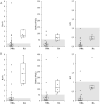Diagnostic performances of manual and automated reticulocyte parameters in anaemic cats
- PMID: 29172918
- PMCID: PMC11129255
- DOI: 10.1177/1098612X17699067
Diagnostic performances of manual and automated reticulocyte parameters in anaemic cats
Abstract
Objectives The objective of this study was to evaluate the diagnostic performances of manual and instrumental measurement of reticulocyte percentage (Ret%), reticulocyte number (Ret#) and reticulocyte production index (RPI) to differentiate regenerative anaemia (RA) from non-regenerative anaemia (NRA) in cats. Methods Data from 106 blood samples from anaemic cats with manual counts (n = 74; 68 NRA, six RA) or instrumental counts of reticulocytes (n = 32; 25 NRA, seven RA) collected between 1995 and 2013 were retrospectively analysed. Sensitivity, specificity and positive likelihood ratio (LR+) were calculated using either cut-offs reported in the literature or cut-offs determined from receiver operating characteristic (ROC) curves. Results All the reticulocyte parameters were significantly higher in cats with RA than in cats with NRA. All the ROC curves were significantly different ( P <0.001) from the line of no discrimination, without significant differences between the three parameters. Using the cut-offs published in literature, the Ret% (cut-off: 0.5%) was sensitive (100%) but not specific (<75%), the RPI (cut-off: 1.0) was specific (>92%) but not sensitive (<15%), and the Ret# (cut-off: 50 × 10³/µl) had a sensitivity and specificity >80% and the highest LR+ (manual count: 14; instrumental count: 6). For all the parameters, sensitivity and specificity approached 100% using the cut-offs determined by the ROC curves. These cut-offs were higher than those reported in the literature for Ret% (manual: 1.70%; instrumental: 3.06%), lower for RPI (manual: 0.39; instrumental: 0.59) and variably different, depending on the method (manual: 41 × 10³/µl; instrumental: 57 × 10³/µl), for Ret#. Using these cut-offs, the RPI had the highest LR+ (manual: 22.7; instrumental: 12.5). Conclusions and relevance This study indicated that all the reticulocyte parameters may confirm regeneration when the pretest probability is high, while when this probability is moderate, RA should be identified using the RPI providing that cut-offs <1.0 are used.
Conflict of interest statement
The authors declared no potential conflicts of interest with respect to the research, authorship, and/or publication of this article.
Figures



Similar articles
-
Sensitivity and specificity of manual and automated measurements of reticulocyte parameters for classification of anemia in dogs: 174 cases (1993-2013).J Am Vet Med Assoc. 2016 Oct 1;249(7):776-86. doi: 10.2460/javma.249.7.776. J Am Vet Med Assoc. 2016. PMID: 27654164
-
Clinical utility of immature reticulocyte fraction for identifying early red blood cell regeneration in anemic dogs.J Vet Intern Med. 2023 Mar;37(2):484-489. doi: 10.1111/jvim.16641. Epub 2023 Feb 10. J Vet Intern Med. 2023. PMID: 36762697 Free PMC article.
-
A retrospective study of 1,098 blood samples with anemia from adult cats: frequency, classification, and association with serum creatinine concentration.J Vet Intern Med. 2014 Sep-Oct;28(5):1391-7. doi: 10.1111/jvim.12422. J Vet Intern Med. 2014. PMID: 25274437 Free PMC article.
-
Clinical application of reticulocyte counts in dogs and cats.Vet Clin North Am Small Anim Pract. 2003 Nov;33(6):1223-44, v. doi: 10.1016/s0195-5616(03)00099-8. Vet Clin North Am Small Anim Pract. 2003. PMID: 14664196 Review.
-
Reticulocyte analysis by flow cytometry and other techniques.Hematol Oncol Clin North Am. 2002 Apr;16(2):373-420, vii. doi: 10.1016/s0889-8588(02)00005-9. Hematol Oncol Clin North Am. 2002. PMID: 12094477 Review.
Cited by
-
Regenerative anemia identification in cats: Red blood cell indices or morphology, what to use?Vet World. 2024 Jul;17(7):1591-1595. doi: 10.14202/vetworld.2024.1591-1595. Epub 2024 Jul 24. Vet World. 2024. PMID: 39185061 Free PMC article.
-
Feline non-regenerative anemia: Diagnostic and treatment recommendations.J Feline Med Surg. 2019 Jul;21(7):615-631. doi: 10.1177/1098612X19856178. J Feline Med Surg. 2019. PMID: 31234748 Free PMC article.
References
-
- Cowgill ES, Neel JA, Grindem CB. Clinical application of reticulocyte counts in dogs and cats. Vet Clin North Am Small Anim Pract 2003; 33: 1223–1244. - PubMed
-
- Tvedten H. Laboratory and clinical diagnosis of anemia. In: Weiss DJ, Wardrop KJ. (eds). Schalm’s veterinary hematology. 6th ed. Ames, IA: Wiley-Blackwell, 2010, pp 152–161.
-
- Christian JA. Erythrokinetics and erythrocyte destruction. In: Weiss DJ, Wardrop KJ. (eds). Schalm’s veterinary hematology. 6th ed. Ames, IA: Wiley-Blackwell, 2010, pp 136–143.
-
- Weiss DJ, Tvedten H. Erythrocyte disorders. In: Willard MD, Tvedten H. (eds). Small animal clinical diagnosis by laboratory methods. 5th ed. St Louis, MO: Elsevier Saunders, 2012, pp 38–62.
Publication types
MeSH terms
LinkOut - more resources
Full Text Sources
Other Literature Sources
Medical
Miscellaneous

